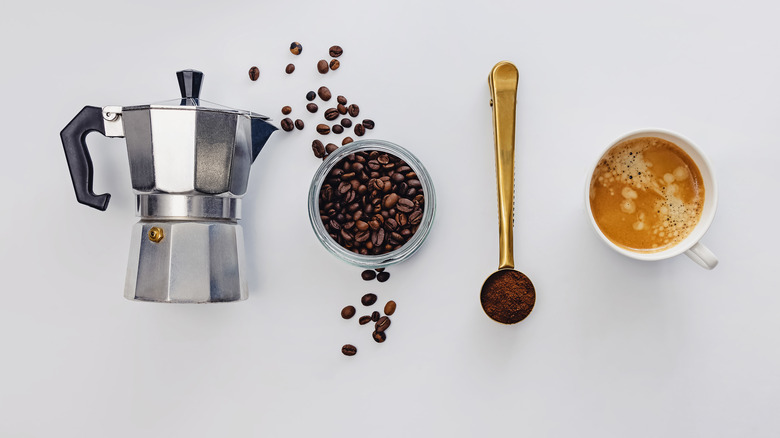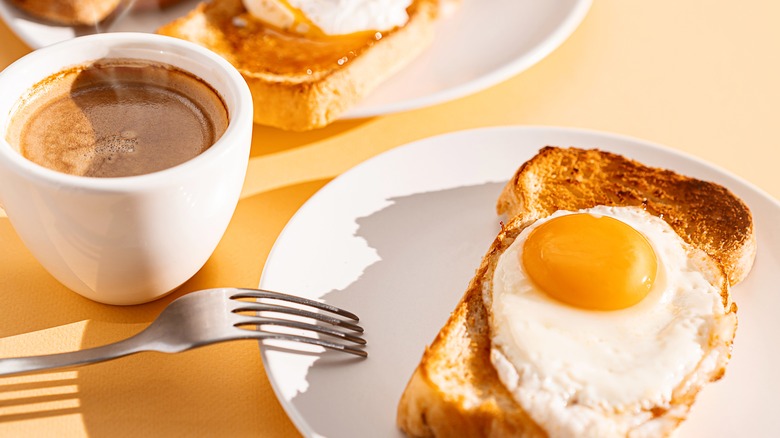Café Con Leche Is An Easy Milky Coffee Drink To Make At Home
If you're looking to try a classic Spanish coffee drink, look no further than café con leche. Luckily, you don't need any fancy equipment or ingredients to make it at home: It's made from equal parts espresso and scalded milk. This creamy coffee is found in most Spanish-speaking countries, each with slight variations on the traditional recipe. Add a bit of sugar and you got the Cuban variety of café con leche, which is also called Cubano con leche. If you want one from Ybor City, Florida, where many Cubans immigrated during the 1880s, you'd add a pinch of salt and sweeten it with condensed milk. Given the drink's simplicity, you could whip it up in no time, additions or not.
It's unclear exactly when and where café con leche was invented. Coffee had come in and out of Spain for quite some time before it was finally popularized in the late 19th century. In fact, it was brought to Spain more than a millennium ago in 711, the year Arabs took over the Iberian Peninsula. Coffee was widely served up until the end of the 15th century when Spain recaptured their land. Perhaps it was due to the supposed un-Christian nature of the drink, but the Spanish hesitated to drink coffee again until the mid-1700s. Italians reintroduced the beverage to Spain during this time and the Spanish embraced coffee, making a plethora of drinks, like the iconic café con leche. So although its origins are murky, café con leche has now been firmly cemented in the coffee cultures of many Spanish-speaking countries, perhaps in part because it's so easily made and enjoyed at home.
How to make café con leche
Café con leche is not just hot drip coffee with milk. Not to be confused with sweeter Spanish coffees, like the café Bombón, a traditional café con leche requires only whole milk and espresso. Since it may be difficult to prepare authentic espresso at home, you could employ a moka pot or a French press with finely ground dark roast coffee. For beans, you can use a Spanish roast, Cuban roast, or Dark French roast, although different regions of the world use varying roasts. It's recommended that you grind your own coffee beans right before using them for a bolder and fresher espresso. Just be sure to use less water so you "pull" a potent shot of coffee — around 1:10 ratio of coffee to water. One ounce of espresso or strong hot coffee will be enough for a small serving of café con leche.
The milk can be scalded using a steamer or brought close to boiling point on a stovetop. The hot milk gives your espresso shot the thick body it needs, without the foam. Whole milk is the best milk for this drink and the traditional milk of choice. Other kinds of milk like 2%, skim, or plant-based milks may not give you the same experience, since the fat of the whole milk really cuts through the acidity of the coffee. Add your espresso first, then pour in the milk to combine, and add sugar if you want a sweetened version of the drink.
How to drink café con leche
In Spain, it's normal to have multiple coffees a day. That being said, a café con leche is usually the first of the day, enjoyed alongside a small breakfast. However, you can really enjoy this simple coffee beverage at any time. It could accompany a dessert like a sweet tortilla or pastry, especially if you have a traditional version without any added sugar. Some like to drink café con leche as a digestif after a big dinner since it can actually help with settling the stomach.
You should also be drinking this pick-me-up in a small glass, as they do in Spain. If you want to go for a Cuban version, add some sugar at the bottom of your cup before pouring in the espresso and milk so that everything dissolves. Cubans love to pair this drink with a thick slice of buttered toast for breakfast – dipping is highly encouraged. No matter what country you use as inspiration or what recipe you decide to go with, there's undoubtedly room for café con leche in your home coffee routine.


